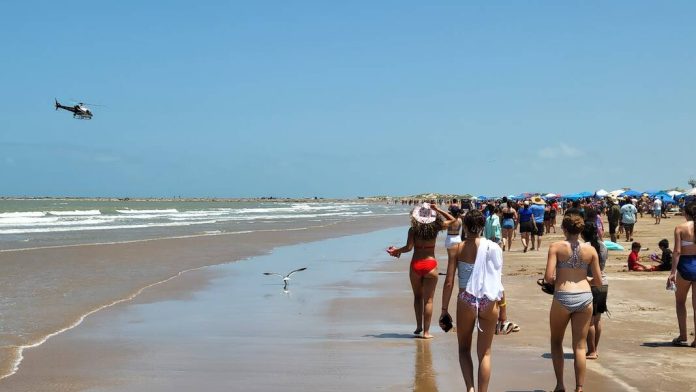
|
Only have a minute? Listen instead
Getting your Trinity Audio player ready...
|
While unusual, the July 4 shark attack on South Padre Island that inured a North Texas couple is a reminder that danger lurks offshore, Cameron County Marine Extension Agent Tony Reisinger said earlier this week.
A shark attacked Tabatha and Cary Sullivent the morning of July 4 in water off Beach Access 14 inside city limits, South Padre Island police said at the time. Tabatha was reported to be recovering in a McAllen hospital and was awaiting surgery on Tuesday, according to a post on Facebook.
Reisinger credited Texas Parks & Wildlife and the Department of Public Safety with quick action to get the beach cleared and the shark out to sea.
“They actually tracked the shark, and they hovered very close to the water, the helicopter did, and the shark ran away from them, the hovering helicopter and the boat they used, toward the north jetty, and then it went offshore out there,” Reisinger said Monday.
He added that drones could prove helpful in the future to monitor sharks when they are thought to be in the area.
Reisinger has fished for shark on commercial and research vessels here and in Georgia for 42 years. He is a marine biologist with the Texas A&M Extension Service in Cameron County.
One sure-fire way to attract shark is blood in the water. Another is shiny objects, he said.
“We’ve got quite a few species of small sharks and most of them are not considered man-eaters. … I’ve been down there yesterday, the day before, and not too many people are swimming like in the past. It made a difference,” Reisinger said of the uproar the attack caused.
“The one that attacked the lady, she was bleeding profusely, and that shark came back. Sharks are attracted to blood in the water,” Reisinger said, adding that based on the incidence of shark attacks on SPI, the odds of getting attacked by one are less than getting struck by lightning.
Reisinger said he’s been to South Padre Island’s beaches many times over the years and has seen a shark in the water one, maybe two times.

“Sharks are attracted to blood in the water. When we were fishing, we would use animal refuse that had blood in it, and that usually attracted them. South Padre Island is no different than any other beach,” he said.
There’s a number of species here and many of them are protected. If you catch some of these species, you can’t keep them, because they’ve been fished heavily over the past probably 50 years. I know the Japanese fleets were fishing the Gulf of Mexico before we were, and they would keep almost everything that they caught,” Reisinger said.
And then American long-liners were out there, and then Cuban long-liners were fishing the gulf. … Quite a few of the species are in trouble. Hooks are not selective as to what species they catch. … I enjoyed fishing for them. I don’t do it any more, but occasionally I’ll catch one as by-catch. The last one I caught was a bonnethead,” Reisinger added.
Nereyda Bazaldua of Harlingen told the Valley Morning Star on July 4 that her daughter was one of the several people attacked, but was not seriously injured.
“We didn’t even know of the first (shark attack),” Bazaldua said via Facebook. “It could have been worse. But grateful that the shark just scratched her leg with his teeth.”
Archives from The Brownsville Herald show that there was a fatal shark attack on the Island around 1:30 p.m. Sunday, Aug. 19. 1962.
According to the archives, a McAllen machinist named Hans Fix died at Brownsville Mercy Hospital less than three hours after being attacked by a shark “while fishing 150 yards off Andie Bowie Park.”
He was with his wife and four children at the time of the attack that day.
Nayo Perez, a former U.S. Coast Guardsman and Port Isabel resident, told the Herald at the time that a man lost part of a finger in a separate shark attack that occurred on the Island several years prior to the 1962 incident.
RELATED READING:
At least 3 ‘extremely rare’ shark attacks shock South Padre Island coastline
SPI shark attacks conjure dark memories for family of 1962 victim



